Are massage guns effective- debunking the myth
Massage guns are heavily marketed as a substitute for professional therapists, providing benefits such as sports recovery and pain... Read Article
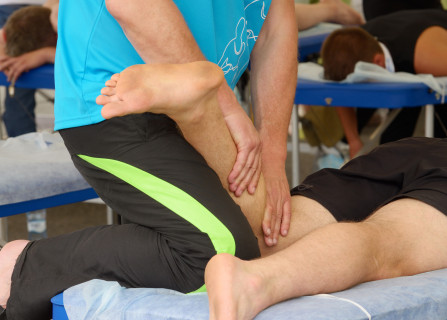
The trouble with having a really good workout is the next day your muscles are sore, and it takes a few days until you can work out with full intensity again. Massages are widely used to reduce this soreness speed recovery, but which is the best type, and when is the best time to have them? Also, using professional therapists is expensive so there are many aids marketed towards self help, but do these work and are they safe?
The good news is that scientists have studied this and done a great number of clinical trials, so we can give you a definitive answer. In this article we’ll share with you which massages give great results, plus which of the self help methods work and which are just a waste of money. The way we’ll do this is to:
Post exercise soreness is also called DOMS or Delayed Onset Muscle Soreness. Lets look at what happens to your muscles to cause this.
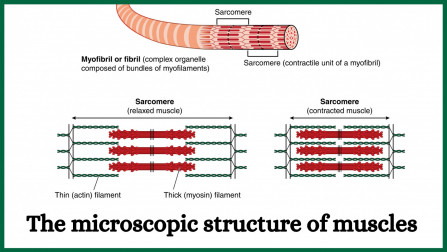
As this diagram shows your muscles are made up of microscopic fibres. Strenuous exercise will damage some of these fibres, and you will also get a build up of metabolic wastes and chemicals that result from the breakdown of damaged tissues.
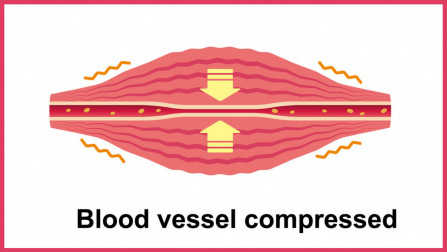
Also, your muscles tend to tighten after exercise. This causes tension in your muscles plus where they attach to your bones. As this diagram shows it will also put pressure on your blood vessels, restricting blood flow. This reduces the clearance of wastes and break down products, plus the re-supply with fresh nutrient.
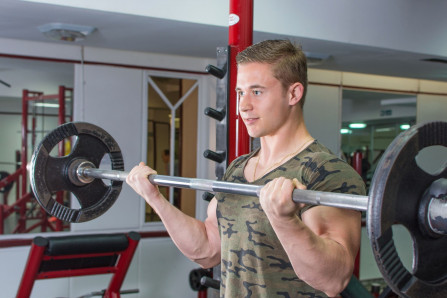
Your muscles will not be able to perform as well suffering from microscopic damage and restricted blood flow. For example, say you could normally do 10 reps of an exercise. The day after a strenuous workout you might only be able to do 6, and not be able to perform fully again until recovered a few days later.
Understanding why your muscle get sore and won’t perform normally after a workout, the main ways massage can help is by:
As discussed, you’ve two main types of massage: using professional therapists, and self massage. Lets look at your options for each.
Professional therapists are widely used for post exercise recovery, and are often employed by sports clubs. They often describe their services using terms like those listed below.
However, we recommend that you not worry too much about what the massage is called. The reality is that they all use the range of techniques listed below. Different styles may emphasise certain techniques or may be more forceful in their approach, but the massage you receive will depend more the skill and experience of the therapist, and whether he or she is performing a more remedial or relaxation massage.
Most of the clinical trials we consulted used one of these terms to describe the type of massage used. However, when we read the fine print to see what was actually done the descriptions were very similar, using a mixture of the techniques below.
Massage techniques
- Effleurage (stroking along the muscle fibres)
- Petrissage (kneading)
- Friction (rubbing across the muscle fibres)
- Pressure (pressing on spots): eg trigger point therapy or acupressure)
For self massage you have two main types to choose from: manual massage and vibration massage.
There are a wide range of contraptions such as balls and rollers that are designed to help self apply the techniques professional therapists use.
There are two types of massagers that vibrate.
Now we’ve seen the options, lets look at what the scientists have found about each.
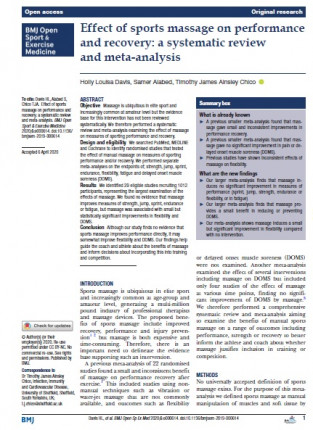
A 2020 scientific review called “Effects of sports massage on performance and recovery” reviewed 29 clinical trials (1). In summary, they found that massage gave a 13% reduction in post exercise soreness (DOMS or Delayed onset Muscle Soreness ) and a 7% increase in flexibility. The increased flexibility would be due to reduced tension in the muscles, which as discussed is ideal to help healing.
Massage has also been shown to reduce this loss of strength and endurance, and speed recovery (2,3). Your muscles will still suffer a reduction in strength and endurance, but not as much, and you will be back to full performance sooner.
We could not find any studies that compared having a massage before or after exercising. All we found was one study that showed it was better to be massaged immediately after exercise rather than having a considerable delay (4).
Balls and foam rollers are widely used as a way get practically unlimited self massage. Their marketing material often refers to studies showing them to be effective. The reality is though, as we discuss in our article Do foam rollers work we found a total of 11 clinical trials and the actual results were either minimal or none. They were certainly no where near those achieved in the trials where professional therapists were used. Further, as discussed in the same article we believe that the real world results from using balls and rollers would be even worse, and in my experience as a Chiropractor for 27 years a lot of people hurt themselves with these for very little benefit.
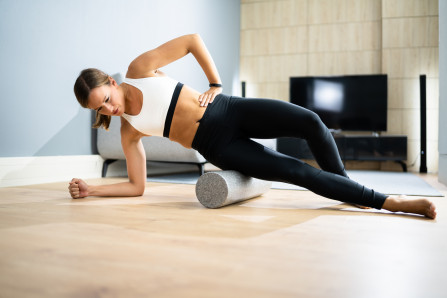
Clinical trials are a perfect world scenerio. Patients are excluded if using balls or rollers would not be suitable or be unsafe. They are then given excellent instructions and supervision. On the other hand in the real world people use balls and rollers without instruction or supervision, and sometimes on conditions where this therapy is inappropriate or unsafe.
There are two types of vibrating massagers available for self use. We’ve summarised the differences below, and got full details in our article Percussion Massage vs Vibration massage.
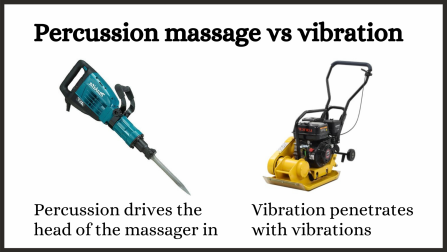
Vibration massage is where vibrations are used to penetrate the muscles and have their therapeutic effects. The way these work is the vibrating head of a massager is placed on a muscle and the vibrations penetrate in a similar way to the way ultrasound does. As discussed in our article The scientifically proven effects of vibration massage- with clinical applications scientists have confirmed that these vibrations have a host of beneficial effects.
The heads of percussion massagers go up and down to, but they do this to drive the head into the muscle like a jackhammer rather than transmit vibration. Massage gun marketers say that this helps the therapy penetrate better. However, the reality is that this is purely a marketing gimmick. By jack hammering rather than vibrating the therapeutic effect of the vibrations is dramatically reduced, while the risk of causing injury is increased. Unfortunately though massage gun marketers make false claims and misrepresent the effectiveness of their product, and those modifications make it so massage guns are actually very dangerous and can potentially cause serious injury or kill you.
We found 11 clinical trials of vibration massage for sports and exercise recovery, summarised in the appendix. All but three gave excellent results, which included those below. Please note that these cannot be applied to massage guns or percussion massagers.
Trial results show that vibration massage is much faster than manual massage. Where the two were directly compared (5) five minutes of vibration gave better results than 15 minutes of massage. This means a typical 30 minute pre or post exercise massage would only take about 10 minutes. Later we discuss how we have developed a vibration massager with four powerful application heads that is much faster still, and could do the equivalent of a full hour massage in minutes.
Why did three trials produced poor results? In our article How to choose a massager we give the appropriate specifications for a therapeutic vibration massager in order to give effective vibration.
All the clinical trials where massage was applied massage using these specifications gave excellent results. On the other hand, as shown below the three trials that gave very poor results used massagers that were totally inadequate to deliver effective therapeutic vibrations. I have emailed each or the researchers offering them the use of effective machines should they ever do further studies.
Some trials used the vibration massage before exercising, some used it after, while others used it after exercising then daily during recovery. From these results:
The practical reality is that if you have your own massager the optimal solution would be to to use it both before and after, then daily during recovery.
We noted that in the trials the researchers used applications ranging for one minute to 30 minutes. From our knowledge of massagers the usage time required would depend on a lot of things including:
However, we can generally say that the trial results were consistent with our clinical experience. The recommendations we advise in our usage guide would be a good start.
Which massage is best for DOMS and sore muscles? Based upon the clinical trials and other scientific evidence, we make the following recommendations.
In the next section we discuss our recommended massage options, but massage is only part of an effective strategy to reduce post exercise soreness and speed recovery. It is important to get adequate sleep, rest, hydration and nutrition. There are also other therapies that may be useful. For a complete strategy please see our Practical, science based guide to post exercise recovery. Please also note that this is for general information only, to be discussed with a professional familiar with your own specific needs.
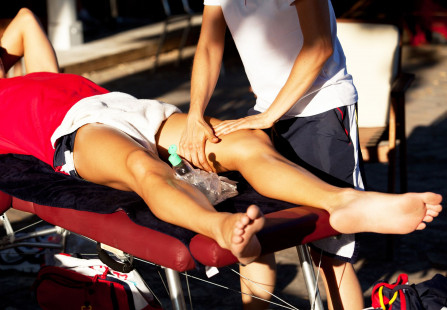
From the clinical trial results, having a massage from a professional therapist either before or after sports or a workout will reduce post exercise soreness and speed recovery. We also note that massages are proven to increase flexibility by 7% which could also help athletic performance and reduce the risk of injuries such as muscle tears.
As discussed, the skill and knowledge of the therapist and the type of massage he or she does is more important than what the massage is called. You may need to seek recommendations or trial some in order to find the best for you.
When massage is done shortly after exercise (such as often happens at a sports club) is likely better than having it done some time later.
As we’ve seen vibration massagers are highly effective. Also because basically all you need to do is sit the head of the massager on the site to be massaged and allow the machine to do the work vibration massage can easily and effectively be self applied. For how to apply vibration massage please see our vibration massage usage guide for more details.
Vibration massage was shown to be useful before exercise, after exercise, and during recovery. If you have your own vibration massage unit the optimum might be to use it before exercise, after exercise, and each day during recovery.
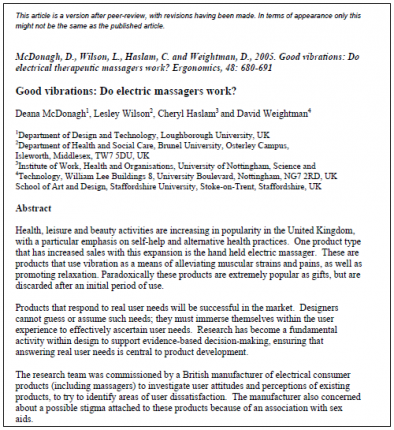
This is where there’s been a problem. A few years ago a team of UK researchers studied the commonly available personal use hand held massagers (6). That is the type of massage available for someone like you to use at home (or the gym). They found that they were ineffective. Basically the manufacturers were more concerned about how their machines looked on shop shelves rather than how they worked.
Since then it’s actually become worse, and now we also have heavily marketed massage guns that are really ineffective and dangerous gimmicks.
As a Chiropractor for over 27 years I had patients that needed a decent effective home massage unit so unable to find anything I was happy to recommend I had my own built. Please allow me to share them with you.
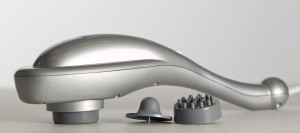
We had our General Purpose Massager built about 10 years and have sold about 100,000 of them. They’re widely used by professionals such as Chiropractors, Osteopaths and Physiotherapists. These professional also recommend them to their patients for self massage. At the business end they have a very strong vibration mechanism, and they’ve got an ergonomically designed handle that makes it extremely easy to massage anywhere on your body.
We have patients use them for a variety of uses including back pain, health and wellness, and of course post exercise recovery and they amazing job. The only issue is that with only a single head you can only massage a limited area at a time. If you wanted to use one before sport or a workout it might take 20-30 minutes to massage all the muscles in your body. For a long time we wanted something that would be just as effective, but work on a much larger area so you could effectively massage your whole body in 5-10 minutes.
Get a General Purpose Massager
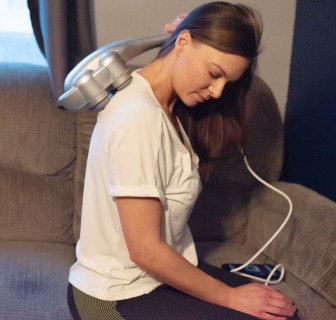
So you can effectively massage larger areas we’ve developed our Ultimate Quad Head Massager. It has the same ergonomically designed handle so you can easily massage anywhere on your body, and it can also be easily used as a chair massager or a cushion massager.
The problem is that massagers with larger heads of multiple heads have always had a problem with harshness, vibration and the machine not adapting the body well. The good news is we’ve solved that problem and built four headed massager that’s actually smoother and more comfortable. It penetrates amazingly well without feeling like it is pummeling you. This is how we’ve done it.
Get an Ultimate Quad Head Massager
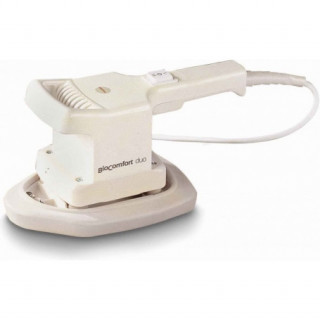
This pic shows a professional massager that was designed to do larger areas. You can see the vibrating pad on the bottom. This would be perfect, except human bodies aren’t flat.
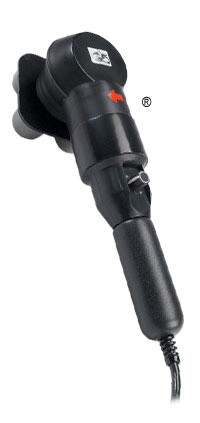
Next we’ll next look at a massager built by one of the most respected makers of professional massagers. It’s a beautifully built machine with four contacts for a larger area, but if you look closely it’s just one head with four balls attached. As you can see in the following diagram massagers follow the laws of physics. If you have great big head each time it pushes down the machine pushes up. That’s going to be quite harsh and vibrate the hell out of the machine you’re trying to hold. Also there’s a lot of inertia in that big plate with the four heads going up and down. If you happen to hit something like a bony bit it’s not going to be very forgiving.
There are also a lot of other multi head machines that use a see saw mechanism. As shown in the following diagram they have exactly the same problem, except that they rock from side to side rather than bounce up and down.
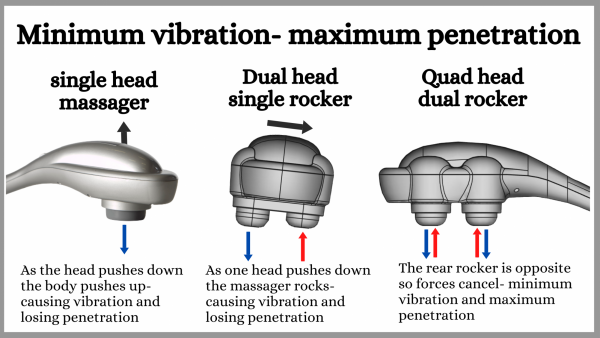
The way we fixed that is by having a mechanisms where two rockers work the opposite to each other. There’s always two heads coming down and two going up, so they balance. It’s the same right to left and front to back. You’ve always got one going down in each side, and you’ve always got a front and back one going down. That’s why these can send vibrations right through you body, yet they’re extraordinarily comfortable.
DrGraeme massagers were originally built by Dr Graeme for use in his clinic, and to prescribe to his patients for additional self use at home. Now these are used by colleagues and other professionals for similar purposes. If you are a professional and wish to know more about this therapy, or possibly get a sample massager to trial please check out our practitioner page.
Study |
What was done |
Results |
Notes |
|---|---|---|---|
Applied vibration to relieve post exercise soreness |
No improvements |
Used an applicator with only 0.9mm travel |
|
Compared massage vs 50Hz vibration. Patients were assessed 24, 48 and 72 hours post exercise. |
Reduced pain, reduced lactic acid |
15 minutes massage was used compared with 5 minutes of vibration, yet the vibration produced better results. |
|
30 minutes of vibration after exercise, then at days 1,2,3 & 4 |
Reduced soreness, faster recovery of range of motion (less stiffness) |
||
50 Hz vibration for one minute before exercising |
Prevented DOMS (post exercise soreness) |
||
20 Hz applied for 20 minutes |
Reduced pain, increased blood flow |
This is outside the optimum 30-55Hz, but still helped |
|
35 Hz applied with a vibrating pad |
22-61% reduction in pain |
Our Ultimate Quad Head Massager can be used as a super effective pad. |
|
10 minutes of 45 Hz done before exercise than twice a day during recovery |
Less loss of strength post exercises and greater oxygen saturation of the tissues |
||
Used an electronic massage device 28-85 Hz |
Reduced pain, increased post exercise strength |
Comment: self treatment allows greater frequency |
|
30-50 Hz vibration before exercise |
Reduced tenderness and DOMS (post exercise soreness) |
||
Used vibration cushion, 73 Hz, 0.5mm |
No improvements |
Woefully inadequate vibration device |
|
Used a 120 Hz, 1.2mm device |
No improvements |
Woefully inadequate vibration device |
We are continually adding more information on research and uses. Subscribe below to have us email them to you "hot off the press".

Several years ago Dr Graeme, a Chiropractor practicing in Victoria, Australia was looking for a serious hand held massager his patients could use at home to get the extra quality massage they needed. The ones he found in the shops and on-line for home use looked nice but were not serious, and... read more
Massage guns are heavily marketed as a substitute for professional therapists, providing benefits such as sports recovery and pain... Read Article
Although clinical trials have shown the use of foam rollers to be safe, experts warn they can be dangerous. The reason trials show they... Read Article
As practitioners we are continually dealing with dysfunctional musculoskeletal systems. Typically dysfunction develops and is perpetuated... Read Article
Using a hand held massager is simple. You place the vibrating head on the muscle, making good contact, and allow the vibrations to... Read Article
Massage therapy has been shown by clinical trials to be an excellent therapy for fibromyalgia. This is because the muscular problems... Read Article
Most professional athletes and sports clubs make heavy use of massage type treatments. The ability to do self massage using a hand held... Read Article
Do not refresh or leave this page until loading complete.